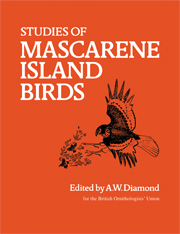Book contents
- Frontmatter
- Contents
- List of contributors
- Foreword
- Introduction
- I The native avifauna of the Mascarene Islands
- 1 An ecological history of the Mascarene Islands, with particular reference to extinctions and introductions of land vertebrates
- 2 The fossil record
- 3 Vocalisations of the endemic land-birds of the Mascarene Islands
- II The surviving native birds of Mauritius
- 4 The ecology of the smaller land-birds of Mauritius
- 5 The larger land-birds of Mauritius
- III The surviving native birds of Réunion and Rodrigues
- 6 The ecology of the surviving native land-birds of Réunion
- 7 Notes on the nesting of Procellariif ormes in Réunion
- 8 Observations on the surviving endemic birds of Rodrigues
- IV Measurements and weights
- 9 Measurements and weights of the surviving endemic birds of the Mascarenes and their eggs
- References
- Index
4 - The ecology of the smaller land-birds of Mauritius
Published online by Cambridge University Press: 04 August 2010
- Frontmatter
- Contents
- List of contributors
- Foreword
- Introduction
- I The native avifauna of the Mascarene Islands
- 1 An ecological history of the Mascarene Islands, with particular reference to extinctions and introductions of land vertebrates
- 2 The fossil record
- 3 Vocalisations of the endemic land-birds of the Mascarene Islands
- II The surviving native birds of Mauritius
- 4 The ecology of the smaller land-birds of Mauritius
- 5 The larger land-birds of Mauritius
- III The surviving native birds of Réunion and Rodrigues
- 6 The ecology of the surviving native land-birds of Réunion
- 7 Notes on the nesting of Procellariif ormes in Réunion
- 8 Observations on the surviving endemic birds of Rodrigues
- IV Measurements and weights
- 9 Measurements and weights of the surviving endemic birds of the Mascarenes and their eggs
- References
- Index
Summary
Introduction
General
Already famous in the seventeenth century for the Dodo and the quality of its ebony, Mauritius is biologically the best known of the Mascarene Islands. However, ecological studies of the native biota date only from the 1930s, with Vaughan & Wiehé's pioneering work (1937, 1941) on the forests. The basic natural history of some of the birds has been known for two centuries, but no systematic ecological studies had been done before 1973 when Dr S. Temple and the BOU Expedition began work. Most of the native forest birds, all endemic or shared only with Réunion, had been considered endangered for over a century (E. Newton 1865b), so their study was overdue. The historical background of the abundance and distribution of Mauritian birds is given by Clark (1859), E. Newton (1861b), Carié (1904), Meinertzhagen (1912), Guérin (1940-53), Rountree et al. (1952) and Newton (1958a). Since 1973, numerous publications on the island birds and their conservation have appeared (e.g. Procter & Salm 1975, Cheke 1978a, Jones & Owadally 1982a, and others cited in appropriate places in the text), and F. Staub has written two books on the birds’ natural history and identification (in French, 1973a; revised in English, 1976). This paper gives the detailed results of the BOU Expedition's observations.
Expedition personnel were based in Mauritius. I was on the island from late September 1973 to late February 1975 except for absences in December 1973, late April to mid-May, June, August and November 1974, and mid-February 1975.1 also made short trips to Rodrigues on several occasions. I re-visited the island briefly in October 1978 under the auspices of the Jersey Wildlife Preservation Trust.
- Type
- Chapter
- Information
- Studies of Mascarene Island Birds , pp. 151 - 207Publisher: Cambridge University PressPrint publication year: 1987
- 21
- Cited by

